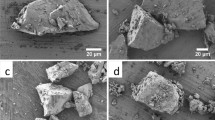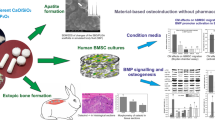Abstract
Boron-containing bioactive glasses (BGs) are being extensively researched for the treatment and regeneration of bone defects because of their osteostimulatory and neovascularization potential. In this study, we report the effects of the ionic dissolution products (IDPs) of different boron-doped, borosilicate, and borate BG scaffolds on mouse bone marrow stromal cells in vitro, using an angiogenesis assay. Five different BG scaffolds of the system SiO2–Na2O–K2O–MgO–CaO–P2O5–B2O3 (with varying amounts of SiO2 and B2O3) were fabricated by the foam replication technique. Bone marrow stromal cells were cultivated in contact with the IDPs of the boron-containing BG scaffolds at different concentrations for 48 h. The expression and secretion of vascular endothelial growth factor (VEGF) from the cultured cells was measured quantitatively using the VEGF ELISA Kit. Cell viability and cell morphology were determined using WST-8 assay and H&E staining, respectively. The cellular response was found to be dependent on boron content and the B release profile from the glasses corresponded to the positive or negative biological activity of the BGs.
Similar content being viewed by others
References
Lovett M, Lee K, Edwards A, Kaplan DL (2009) Vascularization strategies for tissue engineering. Tissue Eng Part B 15:353–370. doi:10.1089/ten.teb.2009.0085
Kanczler JM, Oreffo RO (2008) Osteogenesis and angiogenesis: the potential for engineering bone. Eur Cell Mater 15:100–114
Trueta J (1964) The role of the vessels in osteogenesis. Plast Reconstr Surg 33:206. doi:10.1097/00006534-196402000-00034
Tatsuyama K, Maezawa Y, Baba H et al (2000) Expression of various growth factors for cell proliferation and cytodifferentiation during fracture repair of bone. Eur J Histochem 44:269–278
Gerstenfeld LC, Cullinane DM, Barnes GL et al (2003) Fracture healing as a post-natal developmental process: molecular, spatial, and temporal aspects of its regulation. J Cell Biochem 88:873–884. doi:10.1002/jcb.10435
Friedenstein AJ, Chailakhjan RK, Lalykina KS (1970) The development of fibroblast colonies in monolayer cultures of guinea-pig bone marrow and spleen cells. Cell Tissue Kinet 3:393–403. doi:10.1111/j.1365-2184.1970.tb00347.x
Horwitz EM, Keating A (2000) Nonhematopoietic mesenchymal stem cells: what are they? Cytotherapy 2:387–388. doi:10.1080/146532400539305
Friedenstein AJ, Petrakova KV, Kurolesova AI, Frolova GP (1968) Heterotopic of bone marrow. Analysis of precursor cells for osteogenic and hematopoietic tissues. Transplantation 6:230–247. doi:10.1097/00007890-196803000-00009
Friedenstein AJ, Deriglasova UF, Kulagina NN et al (1974) Precursors for fibroblasts in different populations of hematopoietic cells as detected by the in vitro colony assay method. Exp Hematol 2:83–92. doi:10.1016/j.exphem.2005.10.008
Coultas L, Chawengsaksophak K, Rossant J (2005) Endothelial cells and VEGF in vascular development. Nature 438:937–945. doi:10.1038/nature04479
Laschke MW, Harder Y, Amon M et al (2006) Angiogenesis in tissue engineering: breathing life into constructed tissue substitutes. Tissue Eng 12:2093–2104. doi:10.1089/ten.2006.12.ft-130
Gorustovich AA, Roether JA, Boccaccini AR (2010) Effect of bioactive glasses on angiogenesis: a review of in vitro and in vivo evidences. Tissue Eng Part B 16:199–207. doi:10.1089/ten.TEB.2009.0416
Jung SB, Day DE (2013) Wound care. US 8,535,710 B2
Jung SB, Day DE (2012) Controlling vessel growth and directionality in mammals and implantable material. US 8,337,875 B2
Hoppe A, Mourino V, Boccaccini AR (2013) Therapeutic inorganic ions in bioactive glasses to enhance bone formation and beyond. Biomater Sci 1:254–256. doi:10.1039/c2bm00116k
Gerhardt LC, Widdows KL, Erol MM et al (2011) The pro-angiogenic properties of multi-functional bioactive glass composite scaffolds. Biomaterials 32:4096–4108. doi:10.1016/j.biomaterials.2011.02.032
Detsch R, Stoor P, Grünewald A et al (2014) Increase in VEGF secretion from human fibroblast cells by bioactive glass S53P4 to stimulate angiogenesis in bone. J Biomed Mater Res Part A 102:4055–4061. doi:10.1002/jbm.a.35069
Gorustovich AA, Porto López JM, Guglielmotti MB, Cabrini RL (2006) Biological performance of boron-modified bioactive glass particles implanted in rat tibia bone marrow. Biomed Mater 1:100–105. doi:10.1088/1748-6041/1/3/002
Haro Durand LA, Vargas GE, Romero NM et al (2015) Angiogenic effects of ionic dissolution products released from a boron-doped 45S5 bioactive glass. J Mater Chem B 3:1142–1148. doi:10.1039/C4TB01840K
Bi L, Rahaman MN, Day DE et al (2013) Effect of bioactive borate glass microstructure on bone regeneration, angiogenesis, and hydroxyapatite conversion in a rat calvarial defect model. Acta Biomater 9:8015–8026. doi:10.1016/j.actbio.2013.04.043
Wang H, Zhao S, Zhou J et al (2014) Evaluation of borate bioactive glass scaffolds as a controlled delivery system for copper ions in stimulating osteogenesis and angiogenesis in bone healing. J Mater Chem B 2:8547–8557. doi:10.1039/C4TB01355G
Zhao S, Wang H, Zhang Y et al (2015) Copper-doped borosilicate bioactive glass scaffolds with improved angiogenic and osteogenic capacity for repairing osseous defects. Acta Biomater 14:185–196. doi:10.1016/j.actbio.2014.12.010
Balasubramanian P, Grünewald A, Detsch R et al (2016) Ion release, hydroxyapatite conversion, and cytotoxicity of boron-containing bioactive glass scaffolds. Int J Appl Glass Sci 10:1–10. doi:10.1111/ijag.12206
Chen QZ, Thompson ID, Boccaccini AR (2006) 45S5 Bioglass-derived glass-ceramic scaffolds for bone tissue engineering. Biomaterials 27:2414–2425. doi:10.1016/j.biomaterials.2005.11.025
Hunziker EB (1994) Mechanism of longitudinal bone growth and its regulation by growth plate chondrocytes. Microsc Res Tech 28:505–519. doi:10.1002/jemt.1070280606
Gerber HP, Vu TH, Ryan AM et al (1999) VEGF couples hypertrophic cartilage remodeling, ossification and angiogenesis during endochondral bone formation. Nat Med 5:623–628. doi:10.1038/9467
Street J, Bao M, DeGuzman L et al (2002) Vascular endothelial growth factor stimulates bone repair by promoting angiogenesis and bone turnover. Proc Natl Acad Sci USA 99:9656–9661. doi:10.1073/pnas.152324099
Zelzer E, McLean W, Ng Y-S et al (2002) Skeletal defects in VEGF(120/120) mice reveal multiple roles for VEGF in skeletogenesis. Development 129:1893–1904
Brown RF, Rahaman MN, Dwilewicz AB et al (2009) Effect of borate glass composition on its conversion to hydroxyapatite and on the proliferation of MC3T3-E1 cells. J Biomed Mater Res Part A 88:392–400. doi:10.1002/jbm.a.31679
Hakki SS, Bozkurt BS, Hakki EE (2010) Boron regulates mineralized tissue-associated proteins in osteoblasts (MC3T3-E1). J Trace Elem Med Biol 24:243–250. doi:10.1016/j.jtemb.2010.03.003
Haro Durand LA, Góngora A, Porto López JM et al (2014) In vitro endothelial cell response to ionic dissolution products from boron-doped bioactive glass in the SiO2 –CaO–P2O5–Na2O system. J Mater Chem B 2:7620–7630. doi:10.1039/C4TB01043D
Dzondo-Gadet M, Mayap-Nzietchueng R, Hess K et al (2002) Action of boron at the molecular level: effects on transcription and translation in an acellular system. Biol Trace Elem Res 85:23–33. doi:10.1385/BTER:85:1:23
Benderdour M, Hess K, Nabet P et al (1998) Boron modulates extracellular matrix and TNF a synthesis in human fibroblasts. Biochem Biophys Res Commun 751:746–751
Fu Q, Rahaman MN, Bal BS et al (2010) Silicate, borosilicate, and borate bioactive glass scaffolds with controllable degradation rate for bone tissue engineering applications. II. In vitro and in vivo biological evaluation. J Biomed Mater Res A 95:172–179. doi:10.1002/jbm.a.32823
Wu C, Miron R, Sculean A et al (2011) Proliferation, differentiation and gene expression of osteoblasts in boron-containing associated with dexamethasone deliver from mesoporous bioactive glass scaffolds. Biomaterials 32:7068–7078. doi:10.1016/j.biomaterials.2011.06.009
Park M, Li Q, Shcheynikov N et al (2004) NaBC1 is a ubiquitous electrogenic Na+-coupled borate transporter essential for cellular boron homeostasis and cell growth and proliferation. Mol Cell 16:331–341. doi:10.1016/j.molcel.2004.09.030
Acknowledgements
The authors acknowledge European Commission funding under the 7th Framework Programme (Marie Curie Initial Training Networks; Grant No. 289958, Bioceramics for bone repair).
Author information
Authors and Affiliations
Corresponding author
Rights and permissions
About this article
Cite this article
Balasubramanian, P., Hupa, L., Jokic, B. et al. Angiogenic potential of boron-containing bioactive glasses: in vitro study. J Mater Sci 52, 8785–8792 (2017). https://doi.org/10.1007/s10853-016-0563-7
Received:
Accepted:
Published:
Issue Date:
DOI: https://doi.org/10.1007/s10853-016-0563-7









